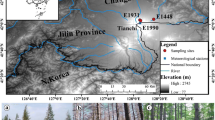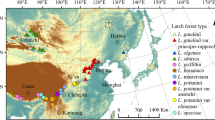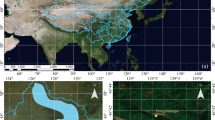Abstract
The eastern slope of Changbai Mountain is characterized by pure larch forest (Larix olgensis) with little human disturbance. Response of tree growth to climate in this area remains unknown. Meanwhile, little is known about how climate variations affect the biomass increase which could be recognized as a three-dimensional tree growth index. The objective of this study is to investigate the climate effects on the radial and biomass growth of larch on eastern slope of Changbai Mountain. Tree-ring width chronologies and mean annual biomass increment were established using tree-ring data. We used correlation analysis and multiple regression analysis to explore the relationship between larch growth and climatic factors from 1957 to 2009. Results show that tree-ring growth and mean annual biomass increment were primarily and significantly affected by previous year climatic variables with slight difference among months. Temperatures were more consistently and strongly correlated to the chronologies and mean annual biomass increment than was precipitation. Temperature is the main factor limiting larch growth on Changbai Mountain and the ongoing climate warming may accelerate the growth of the species. The current stand biomass of the area was 240.72 Mg·ha−1 and the annual stand biomass increment in 2009 was 2.91 Mg·ha−1. In conclusion, the old-growth forest in the study area is still accumulating carbon efficiently.
Similar content being viewed by others
References
Alley R, Berntsen T, Bindoff N L, Chen Z, Chidthaisong A, Friedlingstein P, Gregory J, Hegerl G, Heimann M, Hewitson B (2007). Climate Change, 2007: the physical science basis. Summary for Policy Makers. Contribution of Working Group I to the Fourth Assessment Report of the Intergovernmental Panel on Climate Change. Geneva, Switzerland
Alley W M (1985). The Palmer Drought Severity Index as a measure of hydrologic drought. JAWRA, 21(1): 105–114
Blasing T J, Duvick D (1984). Reconstruction of precipitation history in North American corn belt using tree rings. Nature, 307(5947): 143–145
Case M J, Peterson D L (2007). Growth-climate relations of lodgepole pine in the North Cascades National Park, Washington. Northwest Sci, 81(1): 62–75
Cook E R (1985). A time-series analysis approach to tree-ring standardization. Dissertation for Ph.D Degree. University of Arizona, Tucson
Cook E R, Holmes R L (1986). User manual for ARSTAN Laboratory of Tree Ring Research. University of Arizona, Tucson
Curtis P S, Hanson P J, Bolstad P, Barford C, Randolph J C, Schmid H P, Wilson K B (2002). Biometric and eddy-covariance based estimates of annual carbon storage in five eastern North American deciduous forests. Agric Meteorol, 113(1–4): 3–19
Dai A, Trenberth K E, Qian T (2004). A global dataset of Palmer Drought Severity Index for 1870–2002: relationship with soil moisture and effects of surface warming. J Hydrometeorol, 5(6): 1117–1130
Dai L, Wu Y, Han S, Li Y (2008). Effects of great volcanic eruption on historical vegetation succession on eastern slope of Changbai Mountains. Chin J Ecol, 27(10): 1771–1778 (in Chinese with English abstract)
Dang H S, Jiang M X, Zhang Q F, Zhang Y J (2007). Growth responses of subalpine fir (Abies fargesii) to climate variability in the Qinling Mountain, China. For Ecol Manag, 240(1–3): 143–150
Esper J, Cook E R, Schweingruber F H (2002). Low-frequency signals in long tree-ring chronologies for reconstructing past temperature variability. Science, 295(5563): 2250–2253
Fan Z X, Brauning A, Cao K F (2008). Annual temperature reconstruction in the central Hengduan Mountains, China, as deduced from tree rings. Dendrochronologia, 26(2): 97–107
Foster T E, Brooks J R (2001). Long-term trends in growth of Pinus palustris and Pinus elliottii along a hydrological gradient in central Florida. Can J For Res, 31(10): 1661–1670
Fritts H C (1976). Tree Rings and Climate. London: Academic Press
Gao L S, Zhao X H, Wang X M (2009). Correlations between meteorological factors and growth of Pinus koraiensis after fired. Acta Ecol Sin, 29(11): 5963–5970 (in Chinese with English abstract)
Gong R M, He L Z, Liu Y L, Xu L Y (2000). Effect of Temperature on Shrinkage and Density of Larch Wood from Man-made Forests. China Forest Products Industry, 27(1): 14–16 (in Chinese with English abstract)
Gough C M, Vogel C S, Schmid H P, Su H B, Curtis P S (2008). Multiyear convergence of biometric and meteorological estimates of forest carbon storage. Agric Meteorol, 148(2): 158–170
Harley G L, Grissino-Mayer H D, Horn S P (2011). The dendrochronology of Pinus elliottii in the lower Florida Keys: chronology development and climate response. Tree-Ring Research, 67(1): 39–50
Henderson J P, Grissino-Mayer H D (2009). Climate-tree growth relationships of longleaf pine (Pinus palustris Mill.) in the Southeastern Coastal Plain, USA. Dendrochronologia, 27(1): 31–43
Holmes RL (1983). Computer-assisted quality control in tree-ring dating and measurement. Tree-ring Bull, 43(1): 69–78
Kimmins J P (1987). Forest Ecology. New York: Macmillan Publishing Company
Kimmins J P, Blanco J A, Seely B, Welham C, Scoullar K (2008). Complexity in modelling forest ecosystems: how much is enough? For Ecol Manage, 256(10): 1646–1658
Kirdyanov A, Hughes M, Vaganov E, Schweingruber F, Silkin P (2003). The importance of early summer temperature and date of snow melt for tree growth in the Siberian Subarctic. Trees (Berl), 17(1): 61–69
Kozlowski T T (1971). Growth and Development of Trees. Vol. II. Cambial Growth, Root Growth and Reproduction Growth. New York: Academic Press
Liang E, Shao X, Qin N (2008). Tree-ring based summer temperature reconstruction for the source region of the Yangtze River on the Tibetan Plateau. Global Planet Change, 61(3–4): 313–320
Linares J C, Delgado-Huertas A, Carreira J A (2011). Climatic trends and different drought adaptive capacity and vulnerability in a mixed Abies pinsapo-Pinus halepensis forest. Clim Change, 105(1–2): 67–90
Lindsey A A, Newman J E (1956). Use of official weather data in spring time: temperature analysis of an Indiana phenological record. Ecology, 37(4): 812–823
Litton C M, Raich J W, Ryan M G (2007). Carbon allocation in forest ecosystems. Glob Change Biol, 13(10): 2089–2109
Lo Y H, Blanco J A, Kimmins J P (2010a). A word of caution when projecting future shifts of tree species ranges. For Chron, 86: 312–316
Lo Y H, Blanco J A, Seely B, Welham C, Kimmins J P (2010b). Relationships between climate and tree radial growth in interior British Columbia, Canada. For Ecol Manage, 259(5): 932–942
Luyssaert S, Schulze E D, Börner A, Knohl A, Hessenmöller D, Law B E, Ciais P, Grace J (2008). Old-growth forests as global carbon sinks. Nature, 455(7210): 213–215
Miyamoto Y, Griesbauer H P, Scott Green D (2010). Growth responses of three coexisting conifer species to climate across wide geographic and climate ranges in Yukon and British Columbia. For Ecol Manage, 259(3): 514–523
Moore D J P, Aref S, Ho R M, Pippen J S, Hamilton J G, de Lucia E H (2006). Annual basal area increment and growth duration of Pinus taeda in response to eight years of free-air carbon dioxide enrichment. Glob Change Biol, 12(8): 1367–1377
Ohtsuka T, Saigusa N, Koizumi H (2009). On linking multiyear biometric measurements of tree growth with eddy covariance-based net ecosystem production. Glob Change Biol, 15(4): 1015–1024
Orvis K H, Grissino-Mayer H D (2002). Standardizing the reporting of abrasive papers used to surface tree-ring samples. Tree-Ring Research, 58(1–2): 47–50
Rinn F (2005). TSAP-Win. Time Series Analysis and Presentation for Dendrochronology and Related Applications. Version 0.53 for Microsoft Windows. User Reference
Sánchez-Salguero R, Navarro R M, Camarero J J, Fernández-Cancio A (2010). Drought-induced growth decline of Aleppo and maritime pine forests in south-eastern Spain. For Syst, 19(3): 458–470
Shao X M, Wu X D (1994). Tree-ring chronologies for Pinus armandi Franch from Huashan, China. Acta Geogr Sin, 49(2): 174–181 (in Chinese with English abstract)
Shao X M, Wu X D (1997). Reconstruction of climate change on Changbai Mountain, Northeast China using tree-ring data. Quatern Sci, 1: 76–85 (in Chinese with English abstract)
Stokes M A, Smiley T L (1968). An Introduction to Tree-Ring Dating. Chicago & London: University of Chicago Press
Su M F, Wang H J (2007). Relationship and its instability of ENSO-Chinese variations in droughts and wet spells. Sci China Ser D, 50(1): 145–152
Vaganov E A, Hughes M K, Kirdyanov A V, Schweingruber F H, Silkin P P (1999). Influence of snowfall and melt timing on tree growth in subarctic Eurasia. Nature, 400(6740): 149–151
Vaganov E A, Hughes M K, Shashkin A V (2006). Growth Dynamics of Conifer Tree Rings: Images of Past and Future Environments. Berlin/Heidalberg: Springer Verlag
Wigley T M L, Briffa K R, Jones P D (1984). On the average value of correlated time series, with applications in dendroclimatology and hydrometeorology. J Clim Appl Meteorol, 23(2): 201–213
Wu X D (1990). Application of tree ring analysis to the study on environment variation. Quatern Sci, 10(2): 188–196 (in Chinese with English abstract)
Wu X D, Shao X M (1996). A preliminary study on impact of climate change on tree growth using tree ring-width data. Acta Geogr Sin, 51: 92–101 (in Chinese with English abstract)
Xu Z G (2009). General Plant Pathology. Beijing: Higher Education Press (in Chinese)
Yang H X, Xie H S (1994). Study on the reconstruction of disturbance history of Pinus koraiensis mixed forest in Changbai Mountain. Chin J Plant Ecol, 18(3): 201–208 (in Chinese with English abstract)
Yu D, Wang G G, Dai L, Wang Q (2007). Dendroclimatic analysis of Betula ermanii forests at their upper limit of distribution in Changbai Mountain, Northeast China. For Ecol Manage, 240(1–3): 105–113
Yu D, Wang Q, Wang Y, Zhou W, Ding H, Fang X, Jiang S, Dai L (2011). Climatic effects on radial growth of major tree species on Changbai Mountain. Ann Sci, 68(5): 921–933
Yu D, Wang S, Tang L, Dai L, Wang Q, Wang S (2005). Relationship between tree-ring chronology of Larix olgensis in Changbai Mountains and the climate change. Chinese Journal of Applied Ecology, 16(1): 14–20 (in Chinese with English abstract)
Zhao S Q, Fang J Y, Zong Z J, Zhu B, Shen H H (2004). Composition, structure and species diversity of plant communities along an altitudinal gradient on the northern slope of Mt. Changbai, Northeast China. Biodivers Sci, 12(1): 164–173
Zhu H F, Fang X Q, Shao X M, Yin Z Y (2009). Tree ring-based February-April temperature reconstruction for Changbai Mountainin Northeast China and its implication for East Asian winter monsoon. Clim Past, 5(4): 661–666
Author information
Authors and Affiliations
Corresponding author
Rights and permissions
About this article
Cite this article
Lin, B., Xu, Q., Liu, W. et al. Dendrochronology-based stand growth estimation of Larix olgensis forest in relation with climate on the eastern slope of Changbai Mountain, NE China. Front. Earth Sci. 7, 429–438 (2013). https://doi.org/10.1007/s11707-013-0401-z
Received:
Accepted:
Published:
Issue Date:
DOI: https://doi.org/10.1007/s11707-013-0401-z




